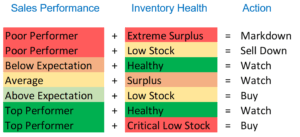[ad_1]
By Jim Lewis, CEO Enhanced Retail Solutions LLC
At a recent lecture at the University of Florida I provided a very brief introduction to retail analytics. The advancement of technology over the last 20 years has brought increased sophistication to the field. Yet for this presentation I wanted to boil it down to its simplest form.
Inventory As an Investment
We discussed how wholesale and retail planners must have similar skill sets as stockbrokers and investors. Except instead of stocks, bonds or securities, the assets (or liabilities) are inventory. Capital is invested in inventory and the faster it can be turned with the highest profit is the objective. Just like investors, planners must monitor the position and performance of their inventory investments.
Based on the trends they see, there are basically 4 actions they can take: buy more, hold it, promote it, or mark it down (sell off). The measurements (KPI’s) they use to make those decisions vary by product category and retail philosophy but the 3 most popular are sell through, weeks of supply and revenue. For a comprehensive list of measurements and how to use them, visit our resources page.

Combining POS sales measurement with Inventory Health to determine action
Interpreting POS Data
Knowing how to interpret the data is the tricky part. Expertise is required to know the level of how “good” or “bad” performance is. Artificial intelligence platforms are helping with this, such as Retail Narrative, but the logic is simple. You can set criteria based on averages or goals for each statistic and then tie the results to actions. For example, if an item is performing above expectations and inventory is below an acceptable level, you buy more. If an item is performing below expectations yet the inventory is healthy, the action is to continue to watch it.

Shows inventory investment by category
POS reporting with this kind of logic built in will enable you to quickly filter and prioritize actions. Knowing how much of your inventory is designated as good (active), watch or in sell down mode provides a better handle on where your total business is headed. For example, if too much of the inventory is in the markdown phase without a lot of good selling active items, you’re in trouble.
We moved on to more advanced topics including regional and demographic analysis, price elasticity and the importance of tracking lost sales. Technology has allowed us to do so much more, faster- but we still need process (discipline of a planner) to make decision making more effective. If you want to improve your retail acumen contact us today.
[ad_2]
Source link





More Stories
Brick and Mortar Retail Stores Vs Online Gifts Shopping – Choose Wisely
Ten Book Options to Use For Business Gifts
The Five Best Places to Look to Keep Up With Trending Fashion